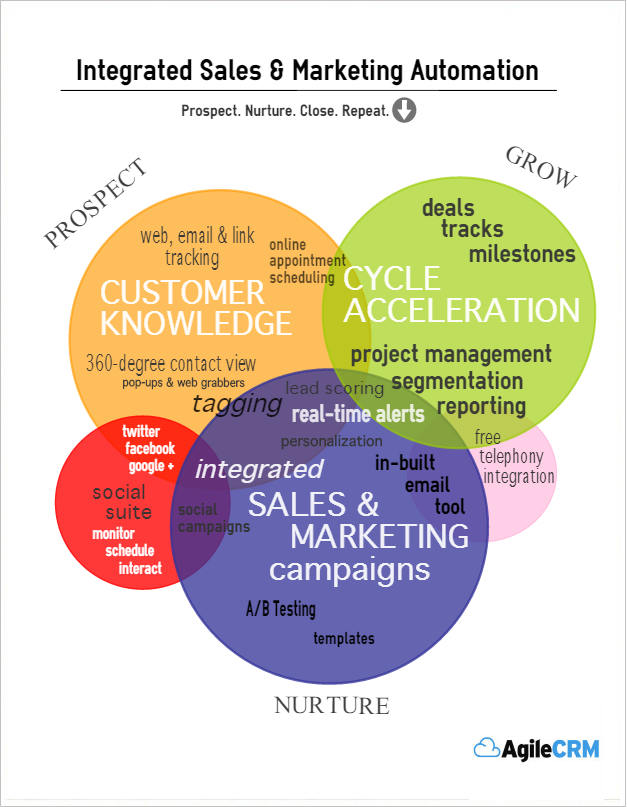Top 5 Reasons to Combine Sales and Marketing Automation
Leads keep slipping through the cracks? Spending too much time with the wrong leads? Don’t know much about segmentation and are afraid to ask? Let’s be honest. Sales and marketing are no longer separate processes. Customers expect more from your business than ever before, and if you’re still using a random bundle of products in a frantic attempt at gathering leads and closing deals, you’re not only wasting time — you’re losing money.

Forward-thinking SMBs needs a complete sales and marketing solution. If you’re really looking for cycle acceleration, it’s essential to integrate customer knowledge and behavior tracking with automated, cross-channel campaigns.

Sales and marketing are changing — they’re evolving together — and your CRM should reflect this evolution. We’ve heard a lot of great feedback about our post on why we built Agile CRM. When businesses sign up for Agile CRM, they often write to let us know how glad they are to have found an all-in-one solution that combines sales enablement, marketing automation, web engagement and social outreach. As our combined CRM and MA product continues to evolve to include an even wider and more dynamic sales automation feature set, here are our top five reasons to combine what used to be thought of as totally separate processes.
Top 5 Reasons to Combine Sales and Marketing Automation
1. Your Sales & Marketing Will No Longer Be Misaligned
Despite understanding that sales and marketing are no longer mutually exclusive processes, too many modern businesses use either an outdated sales model or an ineffective mish-mash of marketing automation and lead-gen tools. They segregate their sales and marketing teams rather than sharing data, goals and techniques. In this old model, nobody’s totally accountable and time and money are inevitably wasted.
Integrating sales automation with marketing automation establishes the three main pillars of perfectly aligned teams.
- Common goals and definitions: From full-cycle lead scoring to shared KPIs, everyone at your company will now be able to work with the same data, toward shared goals.
- Consistent messaging: Easily push consistent messages across channels and campaigns. Give prospects and customers a clearer, more consistent view of your business and they will respond with bigger buys and greater devotion to your product.
- Accountability: Integrated sales and marketing automation leads to accountable teams, accountable sales and marketing processes, and accountable data. It’s that simple.
2. No More Data Leaks
Modern businesses know that they need to engage prospects 24/7, but how can you do this without increasing data leaks and ending up with broken sales processes?
- Dramatically more conversions: 55% of companies fail to consolidate their databases with automation, and as a result 79% of marketing leads never convert into sales. Consolidation will get you back on track.
- Complete transparency: No more ‘blame game’. Plugging data leaks with consolidation means that you’ll always know when, how and why a lead is qualified.
- Automation as a two-sided coin: Your MA software should reflect your point of view in terms of campaigns and milestones, but it should also be built around your customers – what they do, where they hang out and what they’re looking for, from the moment they first browse your site, through every sales meeting and closed deal.
3. Smarter Prospecting & Better Nurturing
If you’re using a marketing cloud for nurturing, that’s 100% awesome, but it’s also only 50% of the puzzle. The other 50% is all about your sales process — not just sales tools, relationship building or analytics, but the entire sales cycle. Consolidating sales and marketing automation means that you can automate your prospecting in unprecedented ways.
- Dynamic lead scoring: Should your lead scoring be manual or automatic? Both. Automate the lead scoring process based on user behavior and get email reports about the hottest leads. Make sure your sales and marketing teams can adjust lead scores manually as well, whether in response to an email or while on a telephony call.
- Responsive campaigns: Drip marketing is essential because it’s responsive. The next step is to use tag-based segmentation for your sales pipeline as well. Otherwise you’re missing out on a ton of potential business by trying to make customer choices for them rather than with them.
- Hyper-segmentation: Tag leads automatically or manually, then see how they respond to automated campaigns in their particular segment.
- Measurable ROI: Consolidation means that you get actionable insights into every aspect of the sales and marketing process, from prospect interaction with your site, emails or app, to telephony and sales pipelines.
4. Complete View of Customers
Even if your cycle improves (more deals, bigger deals), it can’t accelerate without combined sales and marketing automation. The solution is to use products that enable sales and marketing to always have an accurate, real-time view of customers, whether new web visitors, current customers or hot leads. The new equation is actually pretty simple:
DEEP CUSTOMER KNOWLEDGE + AUTOMATED CAMPAIGNS = CYCLE ACCELERATION
It’s time to accelerate your growth. Sometimes smaller businesses and SMEs make the mistake of seeing the “sales cycle” as another term for a “won deal.” In fact, even as you close a deal, you should be figuring out the best way to retain that customer and provide enticing offers for upgrades.
- Cross-channel tracking: Track web behavior, social activity, telephony interaction, email opens, link clicks, and more.
- 360-degree contact view: Integrating your sales and marketing automation means that you’ll be able to use your CRM’s contact page as a one-stop shop for customer knowledge. Monitor your customers and understand their needs.
- Marketing automation as customer service: Over 70% of most business revenue comes from smart retention. Use automation to provide best-in-class customer service and you’ll see amazing results almost overnight. It’s what we call marketing automation as customer service.
5. Actionable Data & Real-time Alerts
Consolidating sales and marketing automation lets you give your sales team next-gen tools to close more sales, and makes their job easier by enabling smarter selling at every single stop along the customer journey. Consolidation means you can get back to process-oriented business techniques, using data how it’s meant to be used: to grow your business.
- Lead scoring that really works: No more lost profiles, mismatched data sets or subjective qualifications. Consolidated lead scoring keeps you in-the-know.
- Real-time alerts and notifications: Engage your contacts at the perfect time in the sales cycle with alerts and notifications that don’t just tell you when to contact a lead, but why you should contact them and what you should talk about.
- Full-cycle analytics: Understand every aspect of your business with clear metrics and advanced reports and analytics, from cohort analysis to deal pies. Use contact-level analytics as well. Compare the two and make smarter business decisions.
Selling like the Fortune 500 is easy with Agile CRM’s complete sales and marketing automation suite. Get to know what makes your customers tick and you’ll be able to prepare now for next year’s demands. Sign up for an account today.
6 Comments
Eyal Eldar
about 9 years agoI think the combination of marketing and sales is very important, I'm working in a company that have separate departments in separate states(one of marketing and one of sales) and it is very hard to correspond the departments. We are in processes to connect the departments.
ReplySpeedToContact
about 9 years agoMerging sales and marketing optimization together is a great way to increase sales. The ability to work more efficiently by have a single synchronized system can allow sales team to more effectively engage leads. Sales needs to know what marketing is doing and be able to have an understanding of the message they are providing to have better and more relevant conversation with potential clients.
ReplyAlison
about 6 years agoConsistent messaging is key. When sales and marketing departments work together they are able to deliver way better results. And cross-channel tracking is a game changer. When you track phone & email interactions together with website behaviour, you get a clearer view of your own business. Here's a cool list of sales automation tools - https://reply.io/sales-automation-tools-2018#1
Reply